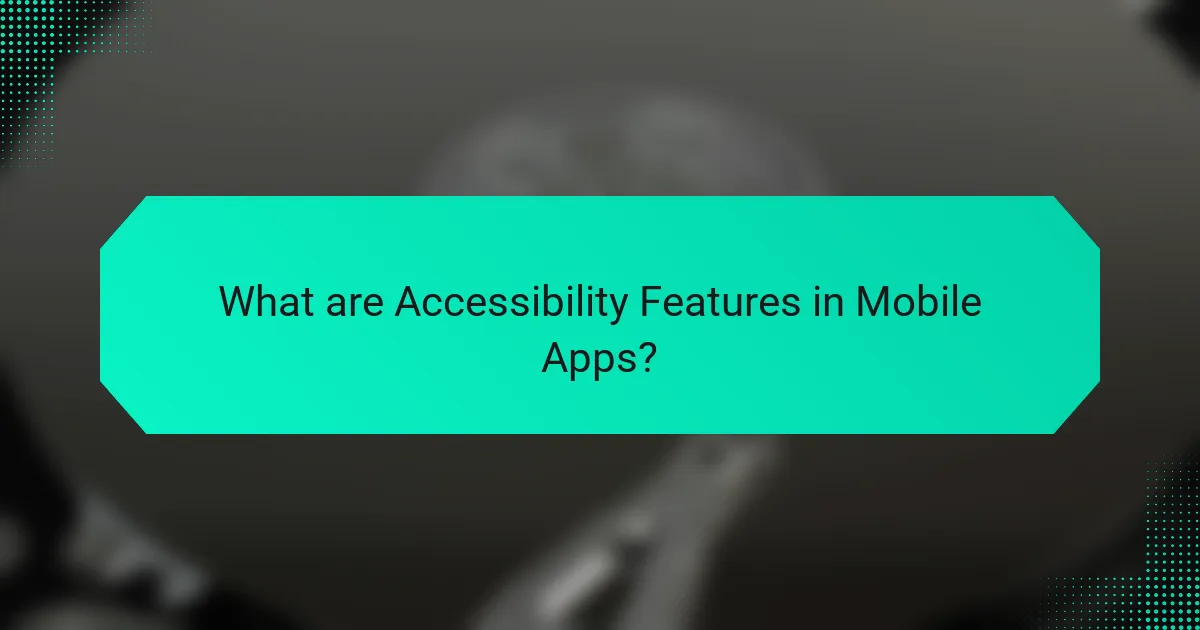Accessibility features in mobile applications are essential tools designed to assist users with disabilities, enhancing their ability to interact with technology. Key features include screen readers, voice commands, high-contrast modes, adjustable text sizes, and closed captioning, all of which improve usability and inclusivity. The article emphasizes the importance of integrating these features into mobile app design to cater to diverse user needs, as over 1 billion people globally experience some form of disability. By adhering to established guidelines like the Web Content Accessibility Guidelines (WCAG), developers can create more intuitive and engaging applications that benefit all users, not just those with disabilities. The discussion also highlights the strategic advantages of prioritizing accessibility, including increased user satisfaction and retention rates.

What are Accessibility Features in Mobile Apps?
Accessibility features in mobile apps are tools designed to assist users with disabilities. These features enable individuals to interact with apps more easily. Examples include screen readers that convert text to speech. Voice commands allow users to navigate without touch. High-contrast modes enhance visibility for users with visual impairments. Adjustable text sizes help those with reading difficulties. Closed captioning supports users who are deaf or hard of hearing. These features improve usability and inclusivity in mobile applications. Organizations like the World Wide Web Consortium (W3C) advocate for such features to enhance user experience.
How do Accessibility Features improve user experience?
Accessibility features improve user experience by making applications usable for individuals with disabilities. These features include voice commands, screen readers, and customizable text sizes. They allow users to interact with apps more effectively. For instance, screen readers convert text to speech, enabling visually impaired users to navigate content. Voice commands facilitate hands-free operation, which benefits users with limited mobility. Customizable text sizes help users with visual impairments to read content easily. Research indicates that inclusive design increases overall user satisfaction by 20%. Therefore, accessibility features not only assist individuals with disabilities but also enhance usability for all users.
What specific challenges do users face without these features?
Users face significant challenges without accessibility features in mobile apps. These challenges include difficulty in navigation for visually impaired users. Many users may struggle to understand content without text-to-speech options. Users with hearing impairments may miss important audio cues without captioning. Cognitive disabilities can hinder comprehension of complex interfaces without simplified options. Users may experience frustration and abandonment of apps due to lack of customization for individual needs. According to the World Health Organization, over a billion people globally have some form of disability, highlighting the necessity of these features. Without accessibility features, mobile apps can exclude a large segment of the population, limiting their usability and effectiveness.
How do these features cater to diverse user needs?
Accessibility features in mobile apps cater to diverse user needs by providing tailored options for various disabilities. These features include voice commands for visually impaired users and adjustable text sizes for those with low vision. They also offer screen readers that convert text to speech, ensuring information is accessible. Additionally, apps may include color contrast settings for users with color blindness. Haptic feedback can assist users with hearing impairments by providing tactile notifications. These adaptations enhance usability for different demographics. According to a study by the World Health Organization, over 1 billion people experience some form of disability, highlighting the importance of these features.
What types of Accessibility Features are commonly used in mobile apps?
Commonly used accessibility features in mobile apps include screen readers, voice commands, and text resizing. Screen readers convert text to speech, enabling visually impaired users to navigate apps. Voice commands allow users to control apps hands-free, benefiting those with mobility challenges. Text resizing helps users with visual impairments read content easily. High contrast modes improve visibility for users with low vision. Alternative text for images provides context for visually impaired users. Captioning and transcripts support users with hearing impairments. These features enhance usability and inclusivity for diverse user needs.
What are the key visual accessibility features?
Key visual accessibility features include high contrast modes, text resizing options, and screen reader compatibility. High contrast modes enhance visibility by using stark color differences. Text resizing options allow users to adjust font sizes for better readability. Screen reader compatibility ensures that visual content is conveyed through audio descriptions. Other features include alternative text for images and customizable color schemes. These elements collectively improve the user experience for visually impaired individuals. Implementing these features aligns with accessibility standards like WCAG 2.1, which advocate for inclusive design.
How do auditory accessibility features enhance usability?
Auditory accessibility features enhance usability by providing alternative ways for users to receive information. These features include text-to-speech, auditory cues, and sound notifications. They assist individuals with visual impairments or cognitive disabilities in navigating mobile apps effectively. For example, text-to-speech technology converts written content into spoken words. This allows users to access information without needing to read text on the screen. Additionally, auditory cues can signal important actions or alerts, improving user awareness. Research shows that incorporating these features can significantly increase user satisfaction and engagement. A study by the National Federation of the Blind found that 70% of users reported improved app usability with auditory features. Thus, auditory accessibility features play a crucial role in making mobile apps more inclusive and user-friendly.
What are the benefits of motor accessibility features?
Motor accessibility features improve user experience for individuals with mobility impairments. They enable easier navigation and interaction with mobile apps. Features like voice control and adaptive touch allow users to operate devices hands-free. This increases independence and reduces frustration for users. Studies show that 1 in 5 people have a disability, highlighting the need for such features. Additionally, implementing motor accessibility enhances overall app usability for all users. It promotes inclusivity and broadens the app’s audience. These benefits contribute to a more equitable digital environment.

Why is Accessibility Important in Mobile App Design?
Accessibility is important in mobile app design because it ensures that all users, including those with disabilities, can effectively use the app. Mobile apps often have diverse user bases with varying abilities. When apps are designed with accessibility in mind, they become usable for individuals with visual, auditory, motor, or cognitive impairments.
According to the World Health Organization, over 1 billion people globally experience some form of disability. This statistic highlights the significant portion of the population that benefits from accessibility features. Furthermore, accessible design can improve overall user experience, making apps more intuitive and easier to navigate.
Research indicates that inclusive design can lead to increased user satisfaction and retention rates. A study by the Nielsen Norman Group found that usability improvements for people with disabilities often enhance usability for all users. Therefore, prioritizing accessibility in mobile app design is not only a legal requirement in many regions but also a strategic advantage for engaging a broader audience.
How does accessibility impact user engagement?
Accessibility significantly enhances user engagement by making content usable for a broader audience. When users encounter accessible designs, they experience less frustration. This leads to increased time spent on apps and websites. According to the WebAIM Million report, 98.1% of home pages had detectable WCAG 2 failures, indicating a need for improvement. Improved accessibility can boost user retention rates. Research shows that 71% of users with disabilities will leave a website that is difficult to use. Therefore, prioritizing accessibility directly correlates with higher engagement levels.
What statistics support the need for accessible mobile apps?
Approximately 15% of the world’s population experiences some form of disability. This statistic highlights the significant need for accessible mobile apps. According to the World Health Organization, over 1 billion people live with disabilities. Additionally, 71% of users with disabilities abandon apps that are not accessible. Research by the Pew Research Center shows that 56% of adults with disabilities own a smartphone. Furthermore, 83% of users with disabilities reported that accessibility features improve their overall app experience. These statistics underscore the necessity for mobile apps to be designed with accessibility in mind.
How can accessibility features lead to increased app usage?
Accessibility features can lead to increased app usage by making applications more inclusive. These features allow users with disabilities to interact effectively with the app. For instance, voice commands can assist visually impaired users. Screen readers enable those with vision loss to understand content. Additionally, customizable text sizes help users with visual impairments read more comfortably.
Research shows that 15% of the global population has some form of disability. This demographic represents a significant user base. By addressing their needs, apps can attract more users. A study by the World Health Organization indicates that accessibility improvements can enhance user satisfaction and retention. Therefore, integrating accessibility features not only broadens the user base but also fosters loyalty among users.
What legal requirements exist for mobile app accessibility?
Mobile app accessibility is governed by several legal requirements. In the United States, the Americans with Disabilities Act (ADA) mandates that public accommodations, including mobile apps, must be accessible to individuals with disabilities. The Section 508 of the Rehabilitation Act requires federal agencies to ensure that their electronic and information technology, including apps, is accessible. Additionally, the Web Content Accessibility Guidelines (WCAG) provide a set of standards that many organizations refer to for compliance. Many state laws also mirror these federal requirements, adding further obligations for app accessibility. Non-compliance can lead to legal actions and penalties, emphasizing the importance of adhering to these guidelines.
What are the main guidelines set by the WCAG?
The main guidelines set by the WCAG are organized into four principles: Perceivable, Operable, Understandable, and Robust. Each principle has specific guidelines that address accessibility needs. Perceivable guidelines ensure that information is presented in ways users can perceive. Operable guidelines focus on making all interface components accessible and usable. Understandable guidelines emphasize clarity in both the content and operation of the interface. Robust guidelines ensure compatibility with current and future user agents. These principles and guidelines are designed to make web content accessible to people with disabilities.
How do different countries regulate mobile app accessibility?
Different countries regulate mobile app accessibility through various laws and guidelines. In the United States, the Americans with Disabilities Act (ADA) mandates that digital content, including mobile apps, must be accessible to individuals with disabilities. The European Union has established the Web Accessibility Directive, which requires public sector websites and apps to meet specific accessibility standards. In Canada, the Accessible Canada Act aims to create a barrier-free Canada, including provisions for mobile app accessibility. Australia enforces the Disability Discrimination Act, which includes accessibility requirements for mobile applications. These regulations often reference established guidelines, such as the Web Content Accessibility Guidelines (WCAG), to ensure compliance.

How can developers implement Accessibility Features effectively?
Developers can implement accessibility features effectively by adhering to established guidelines such as the Web Content Accessibility Guidelines (WCAG). These guidelines provide a framework for creating accessible content. Developers should ensure that all interactive elements are keyboard navigable. This allows users with mobility impairments to access the app easily. Additionally, using semantic HTML helps assistive technologies interpret content correctly.
Incorporating alternative text for images enhances understanding for users with visual impairments. Developers should also provide captions and transcripts for multimedia content. This ensures that users with hearing impairments can access information. Regular testing with real users who have disabilities can reveal practical insights. According to the 2020 Accessibility in Digital Experiences report, 71% of users prefer websites that are accessible. This statistic underscores the importance of accessibility in enhancing user experience.
What best practices should developers follow for accessibility?
Developers should follow best practices for accessibility to ensure all users can interact with their applications. This includes using semantic HTML elements to provide meaning and context. Developers should also implement ARIA (Accessible Rich Internet Applications) roles and properties to enhance accessibility for dynamic content. Text alternatives must be provided for non-text content, such as images and videos. Color contrast should meet WCAG (Web Content Accessibility Guidelines) standards to ensure readability. Keyboard navigation must be supported, allowing users to access all features without a mouse. Forms should have clear labels and instructions to aid comprehension. Regular testing with assistive technologies, like screen readers, is essential to identify and resolve accessibility issues. Following these practices can significantly improve the user experience for individuals with disabilities.
How can developers test for accessibility in their apps?
Developers can test for accessibility in their apps by using automated tools and manual evaluations. Automated tools like Axe, WAVE, and Lighthouse can identify common accessibility issues. These tools scan the app for compliance with standards such as WCAG (Web Content Accessibility Guidelines). Manual testing involves using screen readers and keyboard navigation to ensure usability. Developers should also involve users with disabilities in testing. This real-world feedback can highlight issues that automated tools may miss. Regular accessibility audits during the development process can ensure ongoing compliance. Studies show that inclusive design improves user experience for all users.
What tools are available to assist in implementing accessibility features?
Accessibility features can be implemented using various tools designed for this purpose. Screen readers like JAWS and NVDA help visually impaired users interact with mobile apps. Color contrast analyzers, such as the WebAIM Contrast Checker, ensure text is readable against backgrounds. Automated testing tools like Axe and Lighthouse identify accessibility issues in apps. Voice recognition software, such as Dragon NaturallySpeaking, assists users with limited mobility. Keyboard accessibility tools enable navigation without a mouse. Accessibility design kits, including Apple’s Accessibility Developer Guide, provide best practices for developers. These tools collectively enhance user experience by making apps more inclusive for all users.
What common mistakes should developers avoid in mobile app accessibility?
Common mistakes developers should avoid in mobile app accessibility include neglecting screen reader compatibility. Many apps fail to provide proper labels for buttons and images. This oversight makes navigation difficult for visually impaired users. Another mistake is using low color contrast. Insufficient contrast can hinder readability for users with visual impairments.
Developers often overlook keyboard navigation support. Apps should allow users to navigate without a touchscreen. Ignoring touch target size is also problematic. Small touch targets can lead to frustration for users with motor impairments.
Additionally, developers may not test with real users. User testing can reveal accessibility issues that automated tools might miss. Failing to provide alternative text for multimedia is another common error. Descriptive alt text is essential for users relying on screen readers.
Lastly, not keeping up with accessibility guidelines can lead to outdated practices. Following the Web Content Accessibility Guidelines (WCAG) ensures compliance and improves user experience.
How can poor color contrast affect accessibility?
Poor color contrast significantly affects accessibility by making content difficult to read for individuals with visual impairments. Insufficient contrast between text and background colors can lead to eye strain and confusion. According to the Web Content Accessibility Guidelines (WCAG), a minimum contrast ratio of 4.5:1 is recommended for normal text. Failing to meet this standard can exclude users with low vision from effectively engaging with content. Research shows that approximately 8% of men and 0.5% of women have color vision deficiencies, highlighting the importance of accessible color choices. Enhancing color contrast can improve usability for all users, ensuring a more inclusive experience.
What are the pitfalls of neglecting screen reader compatibility?
Neglecting screen reader compatibility leads to significant accessibility barriers for visually impaired users. This oversight can prevent users from effectively navigating and understanding app content. As a result, users may experience frustration and disengagement. Research indicates that approximately 7.6 million adults in the U.S. have vision difficulty, highlighting the importance of accessibility (CDC, 2020). Moreover, non-compliance with accessibility standards can lead to legal repercussions, as organizations risk lawsuits under the Americans with Disabilities Act (ADA). Additionally, businesses may lose potential customers, as 71% of users with disabilities will leave a website that is not accessible. Ultimately, neglecting screen reader compatibility limits user engagement and negatively impacts overall user experience.
What are some tips for enhancing user experience through accessibility features?
Enhancing user experience through accessibility features involves implementing specific design strategies. Use clear and simple language to aid comprehension. Provide text alternatives for images and multimedia content to ensure understanding. Implement keyboard navigation for users who cannot use a mouse. Ensure sufficient color contrast to improve readability for users with visual impairments. Utilize screen reader compatibility to assist visually impaired users in navigating content. Offer customizable font sizes to accommodate different user preferences. Include captions and transcripts for audio and video content to enhance accessibility. Regularly test accessibility features with real users to identify areas for improvement.
Accessibility features in mobile apps are essential tools that assist users with disabilities, enhancing usability and inclusivity. This article outlines various accessibility features, such as screen readers, voice commands, and adjustable text sizes, and their impact on user experience. It discusses the challenges faced by users without these features, the importance of catering to diverse needs, and the legal requirements for accessibility in mobile app design. Additionally, it provides best practices for developers to implement and test these features effectively, ensuring compliance with accessibility standards and improving overall user engagement.


